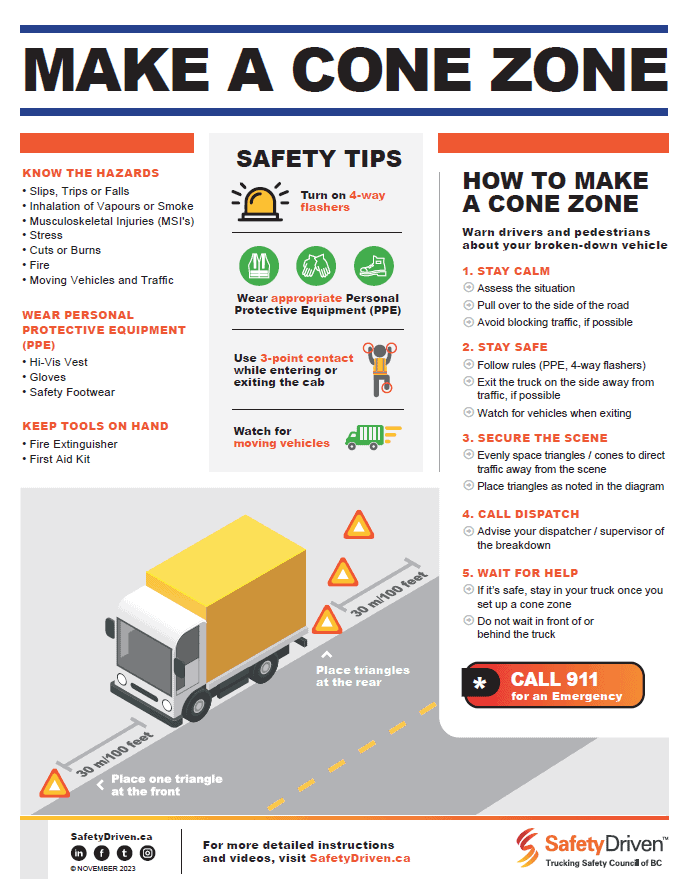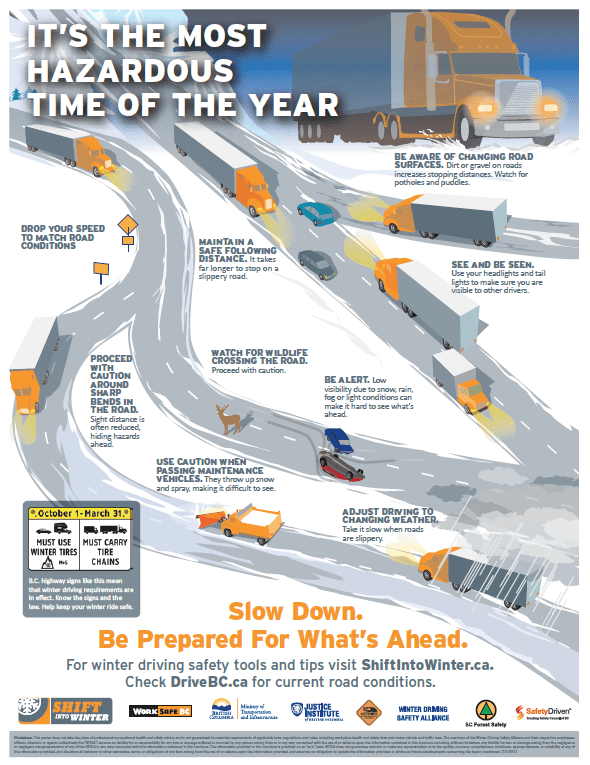
Shift Into Winter Before You Get Behind The Wheel
Mental preparation is key to prevention.
Media Release
Richmond, B.C. /October 10, 2018 – The Winter Driving Safety Alliance — an organization committed to promoting safe winter driving — urges all drivers and workplaces to Shift into Winter by preparing their vehicles and adjusting driving behaviour to reduce the risk of a crash in challenging winter conditions.
Depending on where you drive in the province, winter road conditions vary, from snow and ice in the north and on high mountain passes, to rain and fog commonly found in the Lower Mainland and southern Vancouver Island. B.C. drivers — and employers with workers who operate a fleet or personal vehicles for business purposes — need to think ahead and prepare for changing road and weather conditions, as winter tires or chains are required on designated B.C. routes, starting October 1.
On average, each year in B.C., the number of casualty crashes caused by driving too fast for conditions doubles in December, compared to October — 246 crashes in December compared to 123 in October (police-attended crashes, 2013-2017). The winter months of November, December, and January are a particularly dangerous time for people who drive for work, with nearly 28 percent of all work-related crashes resulting in injury and time-loss claims occurring during these months (WorkSafeBC Data 2013 – 2017).
Starting October 1, most B.C. highways require passenger vehicles to have winter tires (three-peaked mountain and snowflake, or mud and snow) with at least 3.5 mm of tread depth and commercial vehicles to carry chains.
While winter tires, chains and other devices enhance safety by providing better traction in rain, snow, slush and icy conditions, drivers are encouraged to:
- Plan your route ahead of time – check current highway and weather conditions on DriveBC.ca. Delay travel if conditions are unsafe.
- Invest in winter driving training – Learn how to brake safely, how to get out of a skid, and how your car handles in winter weather.
- Slow down – The posted speed limit is the maximum speed under ideal driving conditions, so when inclement weather hits, you should slow down and drive with extra care. Keep at least four seconds distance between you and the vehicle in front of you to allow plenty of room in situations where you may need to brake suddenly on a slippery surface.
- Be prepared – Bring suitable clothing, emergency supplies and a fully charged cell phone if you have one in case of travel delays or a motor vehicle incident.
For employers and supervisors – Employers are legally required to ensure the safety of their workers who operate motor vehicles for business purposes. The Winter Driving Safety online course and Employer Toolkit on the Shift Into Winter website provides useful information for planning, implementing and monitoring a winter-driving safety program.
For more information about what you can do to stay safe while driving this winter, visit ShiftIntoWinter.ca.
Quotes:
Hon. Harry Bains, Minister of Labour:
“Safety on the job must always be the top priority, for employers and workers alike, and it can be particularly difficult when the workplace is mobile. I urge all drivers to be extra vigilant as we move into the winter season with its challenging road conditions. Be alert, be cautious – and let’s all get home safely at the end of each shift.”
Hon. Claire Trevena, Minister of Transportation and Infrastructure:
“We want everyone to drive safely and get home to their families this winter. Safe winter driving is a shared responsibility, and I urge people do their part by using good winter tires, planning ahead by checking DriveBC, slowing down and driving to conditions.”
Darrin McCaskill, Director, Programs, Projects and Initiatives, WorkSafeBC:
“Every day hundreds of British Columbians drive on our roads for work – tow trucks, taxis, transports, delivery vans and buses. Organizations need to prepare now, before road conditions deteriorate, by winterizing their safety plans, assessing and addressing risks and ensuring that workers and contractors are instructed on safe driving procedures. There are a number of resources on the Shift into Winter website. WorkSafeBC can also be contacted directly on its prevention line: 1-888-621-7233.”
About the Winter Driving Safety Alliance
The Winter Driving Safety Alliance is dedicated to improving road safety throughout the province, through the delivery of an annual Shift Into Winter campaign, using multiple platforms to promote safe winter driving and awareness.
Members include Ambulance Paramedics of B.C. (CUPE 873), Automotive Retailers Association, BCAA, BC Forest Safety Council, BC Road Builders and Heavy Construction Association, BC Trucking Association, City of Prince George, Concrete BC, Government of BC, Insurance Corporation of BC, Justice Institute of British Columbia, Kal Tire, Mainroad Group, Pacific Coach Lines, RCMP, SafetyDriven, Tire and Rubber Association of Canada, Wilson M Beck Insurance Group, and WorkSafeBC.
About WorkSafeBC:
WorkSafeBC is an independent provincial statutory agency governed by a Board of Directors appointed by the provincial government. The organization serves approximately 2.4 million workers and 238,000 employers throughout British Columbia. In administering the Workers Compensation Act, the organization is accountable to the public through the provincial government.
– 30 –
Latest Resources
Make a Cone Zone
Dowload this poster for tips on how to make a safe cone zone.Winter Hazards Poster
Drivers need to recognize winter hazards. Share this poster to remind drivers how to ...

